Roland LPX 600
A slick input device for capturing the form of physical objects.
July 1, 2006
By Al Dean
Roland has been pushing its range of digitizing devices for some time, and has gained traction with its LPX products, which have been through several iterations. Last year, the LPX 1200 brought higher accuracy, which was achieved through higher build quality and better optics. This year, the company has released the LPX 600, which takes the lessons learned with the 1200 model and applies them to a larger scanning envelope.
The LPX 600 case is a large light gray box with functional Roland styling and connects to your workstation via a USB plug. Within the large box, spot-beam laser technology is used to triangulate 3D data and scan in both planar and rotary modes. When using planar mode, the system scans a model in sections, using a series of planes placed around the object (controlled by the turntable) and scans data at each. Because the system is aware of the rotation factor, this method can create pretty decent 3D scans without much intervention; with the added benefit that the individual scans are automatically aligned.
As hinted at by the name, under rotary mode, the laser scans as the object rotates and the form is captured in a continuous action. While that’s a basic overview, the actual use of the unit mode to use depends on the software you’re using, and Roland supplies a variety with the LPX 600. As with any reverse engineering hardware, this is key to the success of the solution as a whole.
Software Is Fundamental
The LPX 600 can be supplied with two levels of software support. All of Roland’s 3D products come with a range of tools that can make choosing the correct one confusing. But if viewed from two levels, the mists begin to clear. The base-level offering is now the tried and tested Dr. Picza application, but it is now supplemented with the EZ Scan system. EZ Scan is the ground level, basic scanning application and provides a quick method of capturing 3D data from a physical object; working like a flat-bed scanner, but in 3D.
Once the device is connected and you’ve placed your object on the turntable, the EZ Scan tool presents a clean interface and is driven by two buttons—Preview and Scan (hence the scanner analogy). The Preview button starts a very quick coarse scan of the object and it uses that information to create the parameters for the full scan. There’s a lot of intelligence built into this small application: It will look at the data from the preview and decide on the number of planes required to best capture the geometry.
Feedback is given in terms of time, so you can select the time you want to spend scanning and the system adjusts the parameters (such as pitch and height) accordingly. Obviously, the more data you capture—in terms of number of planes and resolution—the longer the scan will take. As you’d expect, you can dive in and edit these parameters to achieve the result you want, but as a first pass, simply setting the machine to work in a reasonable amount of time can achieve a decent result.
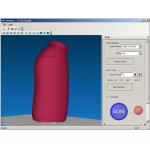 |
| EZ Studio |
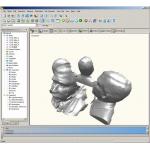 |
| PixForm Pro |
Left: Once the variables are set, the Scan function starts the system working. The object is captured as a series of automatically aligned planar scans and is then automatically merged to create a full representation. At the same time, the system also fills any holes it finds in the scan to create a complete, watertight model. Right: After you’ve captured your distinct and separate scan sets, the PixForm Pro software allows you to import this data. While the full RapidForm applications allow you to import data from a variety of sources, PixForm Pro only works with Roland format files.
EZ Scan works best when you’re scanning cylindrically shaped objects with few undercuts or complex cut-outs (think structural packaging). But what if the object is complex and the use of automated planar scanning is going to miss a lot of critical details? This is when the other software supplied with the system comes in handy. In this case, it makes sense to use a combination of Dr. Picza and the optional add-on PixForm Pro. We’ll deal with them separately.
Dr. Picza software lets you dial down the resolution, limit scans to specific areas, and truly capture the forms you want exactly how you need them. This application will capture a series of scans by focusing on specific areas, often requiring different strategies and moving the part between scans to get the best detail. But once you have a series of scans, how do you collect them together to form a full digital representation of your object?
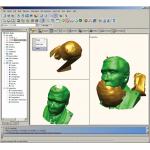 |
| PixForm Pro |
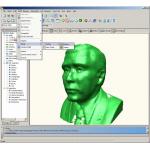 |
| PixForm Pro |
Left: Once the datasets have been imported and cleaned, you then use common features to semi-automatically align the various scan sets into a single registered form. Right: Finally, after the data is aligned, you then merge all the point/poly-meshes into a single dataset.
Roland has teamed with Inus Technology, to supply a subset of its RapidForm system in the form of PixForm Pro, which contains a wealth of tools for cleaning up individual datasets, aligning separate scans, smoothing, filling, and outputting that data as surfaces and curves. Here, the benefits of having high-end reverse-engineering software means that you can take advantage of all the tools available to work with the data for the best results. The limitations are that you don’t get tools like CAD and scan comparison or inspection. Perhaps more importantly, the system will only read in data in Roland’s format, so you can’t work with data captured from other systems. However, you can get everything if you want to spend thousands of dollars to upgrade to the full system.
A Solid Solution
The LPX 600 base package costs $11,995, which includes the hardware, the set-up tools, EZ Studio, Dr. Picza software, and a one-year warranty (extended warranties are available). And, unless you already have in-house advanced reverse engineering software, it might be worth while to spend an additional $5,000 for the optional PixForm Pro; it is a full system that can handle very complex forms and scan jobs when surface data is required.
This is an advanced CAD-neutral solution and a compelling argument for the adoption of noncontact digitizing. You have the ability to scan items accurately and create the scan data you want for whatever purpose and you gain a professional-grade tool to ensure that data is usable. It’s a solid solution and the results you achieve are a direct result of the time and effort you put into the process.
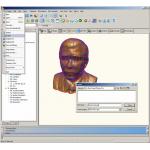 |
| PixForm Pro |
› › PixForm Pro includes some automated surfacing tools, allowing you to export the data as IGES or STEP files. Or it can remain as STL data for rapid prototyping or manufacturing.
Once you have an understanding of the limitations of the system (every reverse engineering process has them), you can quickly establish a workflow to capture the data you want in next to no time and have the tools at hand to deal with those inevitable problematic forms. Roland has learned from its long-standing activity in this market, looked at its current products, and brought an updated combination of both hardware and software to bear. It works.
Al Dean is Technology Editor of the UK’s leading product development and manufacturing journal, MCAD and is Editor of Prototype, for the rapid prototyping and direct manufacturing industry, both available by clicking here. Send your comments about this article through e-mail by clicking here. Please reference “Roland LPX 600, August 2006” in your message.
At a Glance
Roland LPX 600 Technical Specifications
Price
From $11,995
Table Diameter
16 inches
Maximum table load
11 pounds
Plane max. scanning area
width 10 in. /height 16 in.
Rotary max. scanning area
diameter 10 in./ height 16 in.
Plane scanning pitch
width direction 0.8 in. to 10 in.
height direction 0.003 in. to 16 in.
Rotary scanning pitch
circumference 0.18 to 3.6 degrees
height direction 0.004 in. to 16 in..
Repeat accuracy
+/- 0.001 in.
Weight
300lbs
Company Information
LPX 600
Roland DGA Corp.
Irvine, CA
PixForm Pro, RapidForm
INUS Technology
San Jose, CA
Subscribe to our FREE magazine, FREE email newsletters or both!
About the Author
DE’s editors contribute news and new product announcements to Digital Engineering.
Press releases may be sent to them via [email protected].






